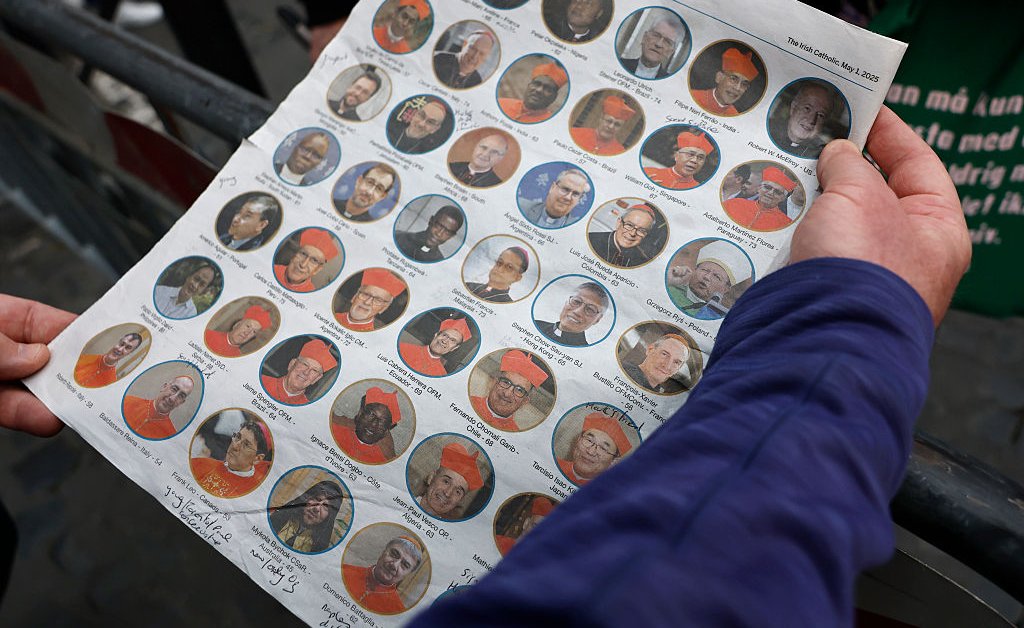Here is a breakdown on the cardinals who are voting.
How many cardinals chose the new pope?
There are 252 cardinals in total, but only those under the age of 80 can take part in the conclave.
While that means that 135 cardinals are eligible to vote, two have announced they will not travel to Rome, leaving 133 cardinals to participate in the conclave.
During the 2013 conclave that chose Francis, there were 207 cardinals—117 of whom were eligible.
Like this year, two cardinals were unable to vote, and thus there were 115 cardinals who entered the conclave.
What countries do the cardinals come from?
According to the Vatican, the cardinals who will elect the new Pope are from 70 countries.
The majority are from Europe, with 52 cardinals, 17 are from Africa, 16 are from North America, 4 are from Central America, 17 are from South America, 23 are from Asia and 4 are from Oceania.
This will be the first papal conclave in which fewer than half the voting cardinals are European, showing a shift away from Europe-centricism in the Catholic church. In fact, it will be the most geographically diverse conclave in history, a legacy in part brought about by Pope Francis—the first Latin-American Pope, who consistently emphasized the importance of this diversity, and dismissed the idea that nationality or geography should determine who became Pope.
He elevated cardinals from several underrepresented countries, including Myanmar and East Timor. Some of Francis’ appointees are from countries that will be represented for the first time in a conclave, including the aforementioned two, Cape Verde, Paraguay, Haiti and South Sudan.
Read More: Who Could Be the Next Pope? These Are the Names to Know
According to the Pew Research Center, after Pope Francis, Europe is still “over represented” in the College of Cardinals, but less so than during his election as Pope in 2013. The most underrepresented region based on population, they calculate, is Latin America, with 41% of the worldwide Catholic population as of 2022 but has only 18% of the voting cardinals.
The country with the most cardinals is overwhelmingly Italy with 17 voting cardinals, followed by the United States with 10, and Brazil with 7. Many countries are only represented by one voting cardinal—including Peru, Serbia, Nigeria, and Sri Lanka.
The selection process
Pope Paul VI ruled in 1970 that cardinals above 80 years old cannot vote for the Pope.
Cardinals are elected by the Pope and hold their position for life. 108 of the cardinals eligible to elect were appointed by Pope Francis to the College of Cardinals, and the remainder were appointed by the previous two Popes, Benedict XVI and John Paul II.
During the 2013 conclave, just 67 cardinals had been elevated by the previous Pope Benedict XVI to compare, and 48 had been elevated by John Paul II, who had been Pope until 2005.
How long have other conclaves taken?
If a conclave does not produce a new pope after 13 days of voting, a runoff election between the two leading candidates is held.
The longest conclave ever took place in the 13th century when the Church took almost three years—over 1,000 days—to elect Pope Clement IV.
Since 1831 however, the process has usually have latest less than a week.
As for more recent papal elections, Pope Francis was elected on the third ballot in 2013, his predecessor Pope Benedict XVI was elected in two days.
Generally, the length of time depends on the first few votes. One vote will be held on the first day of voting. If no candidate receives the necessary 89 votes, four votes will occur over the next two days— two votes each morning, and two votes each afternoon.
These ballots are then burned—and the color of the smoke shows the outside world whether a Pope was chosen or not.
If the smoke emerging from the Sistine Chapel chimney is black, it means no decision was made. If the smoke emerging is white, the public will know a new Pope has been chosen. The ballots are burned each two rounds of voting, unless a Pope is chosen.
Read More: 10 Surprising Facts About Papal Conclaves
If after the third day no decision has been made, the voters are allowed a one day break.
Read the full article here


